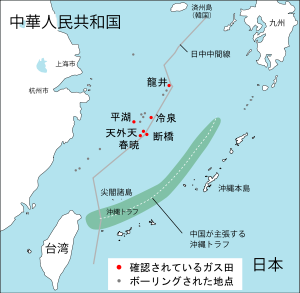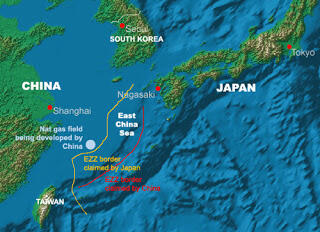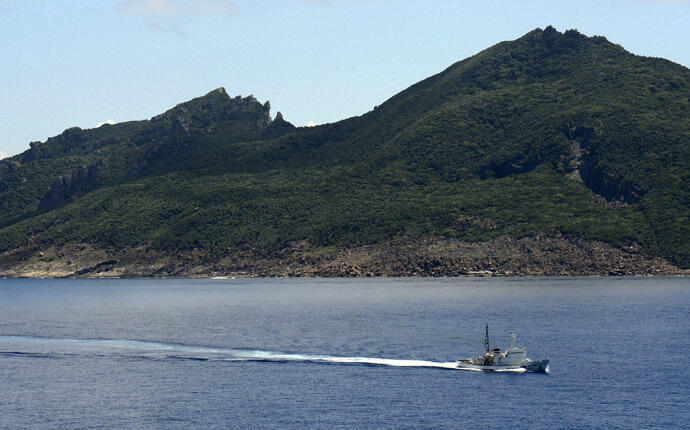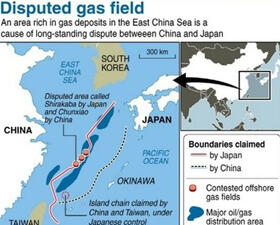TS
st34dy
Panasnya sengketa ladang gas di Laut China Timur
Spoiler for No win win solution:
Japan to deploy ships after China detected drilling in disputed waters - report





Japan has allegedly ordered geological survey ships to prepare for possible deployment after the Chinese were reportedly detected drilling in Japanese waters near the disputed area of the Senkaku Islands in the East China Sea, a source told Reuters.
The Japan Oil, Gas and Metals National Corporation (JOGMEC) has been ordered to put both its survey ships , the Shigen and the Hakurei, on standby and to prepare to deploy without any foreign members of staff on board, according to the source .
Japan warned China not to expand gas exploration in the East China Sea on Thursday, following a media report according to which Chinese state-run oil companies plan to develop seven new gas fields in the sea, possibly siphoning gas from the seabed beneath waters claimed by Japan, Kyodo news agency reported.
"We will never accept development of gas fields in the area over which there are conflicting claims in a unilateral manner," Chief Cabinet Secretary Yoshihide Suga said at a press conference. Though he added that officials are still gathering information to confirm the report.
After in 1968 it was discovered that oil reserves might be found under the sea near the territory of the islands in the East China Sea, sovereignty over them has been long disputed by Japan and China.
Meanwhile, three Chinese maritime vessels were spotted entering Japan’s territorial waters on Thursday morning, the Japanese Coast Guard reported. Beijing said was a routine surveillance and the ships later left the Japanese waters, but remain in the contiguous area, the coast guard added.
This particular intrusion came the day after Prime Minister Shinzo Abe paid a visit to Japan’s southern island of Ishigaki, only 160 km away from the islets claimed by both China and Japan.
During the visit, the Prime Minister repeated Tokyo's stand that the nearby disputed Senkaku Islands are Japanese territory. He added that Japan will not back off on the issue of their sovereignty over the territory which China calls the Diaoyu Islands claiming they were“stolen” from the country at the end of the Sino-Japanese war in 1895.
It is rare for a prime minister to visit Ishigaki, and "it is a strong message for China", Japan's Asahi Television said.
Abe’s statement followed a strong reaction in the Chinese media which accused the Japanese Prime Minister on Thursday of dangerous politics in the period of heightened relations between the two countries.
The People's Liberation Army Daily said Abe was trying to play the "China threat" angle, to win votes in July 21 upper house of parliament elections by paying the visit to the island.
"This kind of 'drinking poison to slake ones thirst' not only threatens regional stability, it gives encouragement to Japan's 'turn to the right'," said the Daily.
The ruling Communist Party's official People's Daily warned that China would never allow itself to be trampled on again, referring to the 1931 Japan invasion and the establishment of a Manchukuo puppet state located in what is now northeast China.
The newspaper claimed that the prime minister is “provoking incidents” aimed to create tension to “push Japan’s military development.”
Surveillance ships from both nations routinely monitor the disputed area. The last time that Chinese ships were spotted there was July 7.
In response to the island dispute and the growing nuclear threat from the Korean Peninsula, Tokyo has raised its defense budget for the first time in 11 years. Moreover, Abe wants to revise Japan's constitution drafted by the United States after World War Two to allow for collective military action. If the Prime Minister’s Liberal Democratic Party (LDP) obtains the majority of votes it will be a step closer to pushing through the amendment.
http://rt.com/news/japan-china-dispu...d-islands-271/
China's East China Sea Gas Exploration Latest Flare-Up In Japan-China Senkaku/Diaoyu Island Dispute
Prime Minister Abe Shinzo’s Liberal Democratic Party (LDP)/New Komeito (NK) coalition is certain to will a huge victory in the July 21 Diet House of Councillors election. Abe will surely win a majority of seats and could reach the two-thirds level that would facilitate his plan to amend Japan’s (U.S. written) “Peace Constitution.”
The election campaign is now in full swing throughout the country. In it we observe the strange but admirable phenomenon of abundant, almost excessive, media coverage being accorded leaders and candidates of fringe and obscure parties. These are labels that might now apply to all except the LDP/NK. The Democratic Party of Japan (DPJ) that ruled for three years until last December has imploded and retains a support level of only some 5%, below that of the Japan Communist Party.
Following the July 21 vote, Abe will have a relatively free hand to push through even the more controversial parts of his agenda, adumbrated in the LDP election “manifesto” summarized in the previous two posts.
But what may be the most fateful issue for Japan has been carefully played down by Abe, and even by the opposition parties, during the election. This is how or whether Japan can or should endeavor to unfreeze relations with China and resolve the Senkaku/Diaoyu island dispute.
The serious and increasingly dangerous rupture with China gained a new dimension–and regained the headlines–on July 5 when Abe, appearing on a Fuji Television program, expressed “deep regret” that China was moving undersea gas field exploration equipment into an area of the East China Sea “in violation of a bilateral agreement.” “I must ask China to honor our agreement,” said Abe.
Abe’s criticism produced a brief flutter of comment in the Japanese media, but was quickly passed over. In Beijing, however, there was a multi-day thunderstorm.
In this instance, as in so many others affecting Japan’s foreign relations–including with the U.S.–we are again witnessing from Abe a maladroitness bordering on incompetence. What is going on here?
The specific issue is Chinese exploration in a section of the East China Sea close to but not over a notional mid-point line (illustrated in the graphic above) that can be drawn longitudinally (roughly north to south) through a large area of ocean and seabed that both China and Japan claim as falling within their respective 200 mile “exclusive economic zones” (EEZ). After Abe’s statement, Chinese official media published maps and diagrams documenting that activity was taking place on the Chinese side of the “mid-point line,” and that China was perfectly within its rights.
A July 4 Nihon Keizai Shimbun article reported that on June 27 the second raking official in Japan’s foreign ministry delivered a formal diplomatic protest of China’s action to the Chinese ambassador to Japan. On July 3, Japan’s cabinet secretary, Suga Yoshihide, stressed to the press that “we will not recognize any unilateral development activities in sea areas where the two countries have overlapping claims.”
Anyone with a knowledge of Chinese negotiating style could have guessed what was coming next.
In response to Suga, on the same day, July 3, China’s deputy foreign ministry spokesman, Ms. Hua Chunying, announced to the press that “we are are conducting exploration activities in sea area under our own administration.” Further, she continued, China has never agreed to and does not recognize any so-called “mid-point line” (my italics). Therefore, “China rejects Japan’s protest.”
Ms. Hua was stating facts in denying that China had ever formally accepted the concept of a “mid-point line.” Formal acceptance would mean recognizing Japan’s EEZ claims. This will never happen, just as China will never formally recognize or accept Japan’s claims to the Senkaku/Diaoyu islands.
Hence Abe was telling a highly provocative untruth when he mentioned an “agreement” with China over exploration in the East China Sea.
But of course there is something more. In June 2008, Japanese and Chinese government negotiators reach tentative agreement that a Chinese gas field development project in the East China Sea called “Shirakaba” by Japan and “Chunxiao” by China should proceed based on Chinese law, but with capital provided by Japanese corporations. Agreement in principle was also reached to establish a joint development zone in a northern area that extended across the notional “mid-point line.” In these discussions both sides set aside the issue of their respective “exclusive economic zones.”
As it happened, the above tentative agreements were scheduled to be formalized in signed agreements in September 2010. However, when Japan-China political relations soured over the collision of a Chinese fishing vessel with a Japanese Coast Guard vessel, China asked for an indefinite postponement of the joint exploration agreement signing. Since then, and particularly as the Senkaku/Diaoyu island dispute has escalated, China has reverted to strict interpretation of and insistence on its EEZ rights.
It is classic Chinese negotiating style to escalate rhetoric (sometimes combined with histrionic gestures) and to elaborately link otherwise seemingly unrelated issues, to bring maximum pressure on the counterparty to make concessions. Subtlety is practiced only in obfuscating sources, not in the message or desired effect. A vivid example of the style was an article penned by “scholars” in the People’s Daily a few weeks ago that called into question Japan’s sovereign claim over Okinawa.
What is going on in the East China Sea is really about the Senkaku/Diaoyu island dispute and China’s determination not to de-escalate pressure for concessions from the Abe government. Abe is also under pressure from the Obama administration to show initiative in trying to resolve the issue, so that the U.S. can continue improving relations with China.
It is obvious that Abe is showing strain, and even reaching for straws, as he stumbles in foreign policy. The pressure on Abe from both Washington nor Beijing will only increase after July 21.
http://www.forbes.com/sites/stephenh...sland-dispute/





Japan has allegedly ordered geological survey ships to prepare for possible deployment after the Chinese were reportedly detected drilling in Japanese waters near the disputed area of the Senkaku Islands in the East China Sea, a source told Reuters.
The Japan Oil, Gas and Metals National Corporation (JOGMEC) has been ordered to put both its survey ships , the Shigen and the Hakurei, on standby and to prepare to deploy without any foreign members of staff on board, according to the source .
Japan warned China not to expand gas exploration in the East China Sea on Thursday, following a media report according to which Chinese state-run oil companies plan to develop seven new gas fields in the sea, possibly siphoning gas from the seabed beneath waters claimed by Japan, Kyodo news agency reported.
"We will never accept development of gas fields in the area over which there are conflicting claims in a unilateral manner," Chief Cabinet Secretary Yoshihide Suga said at a press conference. Though he added that officials are still gathering information to confirm the report.
After in 1968 it was discovered that oil reserves might be found under the sea near the territory of the islands in the East China Sea, sovereignty over them has been long disputed by Japan and China.
Meanwhile, three Chinese maritime vessels were spotted entering Japan’s territorial waters on Thursday morning, the Japanese Coast Guard reported. Beijing said was a routine surveillance and the ships later left the Japanese waters, but remain in the contiguous area, the coast guard added.
This particular intrusion came the day after Prime Minister Shinzo Abe paid a visit to Japan’s southern island of Ishigaki, only 160 km away from the islets claimed by both China and Japan.
During the visit, the Prime Minister repeated Tokyo's stand that the nearby disputed Senkaku Islands are Japanese territory. He added that Japan will not back off on the issue of their sovereignty over the territory which China calls the Diaoyu Islands claiming they were“stolen” from the country at the end of the Sino-Japanese war in 1895.
It is rare for a prime minister to visit Ishigaki, and "it is a strong message for China", Japan's Asahi Television said.
Abe’s statement followed a strong reaction in the Chinese media which accused the Japanese Prime Minister on Thursday of dangerous politics in the period of heightened relations between the two countries.
The People's Liberation Army Daily said Abe was trying to play the "China threat" angle, to win votes in July 21 upper house of parliament elections by paying the visit to the island.
"This kind of 'drinking poison to slake ones thirst' not only threatens regional stability, it gives encouragement to Japan's 'turn to the right'," said the Daily.
The ruling Communist Party's official People's Daily warned that China would never allow itself to be trampled on again, referring to the 1931 Japan invasion and the establishment of a Manchukuo puppet state located in what is now northeast China.
The newspaper claimed that the prime minister is “provoking incidents” aimed to create tension to “push Japan’s military development.”
Surveillance ships from both nations routinely monitor the disputed area. The last time that Chinese ships were spotted there was July 7.
In response to the island dispute and the growing nuclear threat from the Korean Peninsula, Tokyo has raised its defense budget for the first time in 11 years. Moreover, Abe wants to revise Japan's constitution drafted by the United States after World War Two to allow for collective military action. If the Prime Minister’s Liberal Democratic Party (LDP) obtains the majority of votes it will be a step closer to pushing through the amendment.
http://rt.com/news/japan-china-dispu...d-islands-271/
China's East China Sea Gas Exploration Latest Flare-Up In Japan-China Senkaku/Diaoyu Island Dispute
Prime Minister Abe Shinzo’s Liberal Democratic Party (LDP)/New Komeito (NK) coalition is certain to will a huge victory in the July 21 Diet House of Councillors election. Abe will surely win a majority of seats and could reach the two-thirds level that would facilitate his plan to amend Japan’s (U.S. written) “Peace Constitution.”
The election campaign is now in full swing throughout the country. In it we observe the strange but admirable phenomenon of abundant, almost excessive, media coverage being accorded leaders and candidates of fringe and obscure parties. These are labels that might now apply to all except the LDP/NK. The Democratic Party of Japan (DPJ) that ruled for three years until last December has imploded and retains a support level of only some 5%, below that of the Japan Communist Party.
Following the July 21 vote, Abe will have a relatively free hand to push through even the more controversial parts of his agenda, adumbrated in the LDP election “manifesto” summarized in the previous two posts.
But what may be the most fateful issue for Japan has been carefully played down by Abe, and even by the opposition parties, during the election. This is how or whether Japan can or should endeavor to unfreeze relations with China and resolve the Senkaku/Diaoyu island dispute.
The serious and increasingly dangerous rupture with China gained a new dimension–and regained the headlines–on July 5 when Abe, appearing on a Fuji Television program, expressed “deep regret” that China was moving undersea gas field exploration equipment into an area of the East China Sea “in violation of a bilateral agreement.” “I must ask China to honor our agreement,” said Abe.
Abe’s criticism produced a brief flutter of comment in the Japanese media, but was quickly passed over. In Beijing, however, there was a multi-day thunderstorm.
In this instance, as in so many others affecting Japan’s foreign relations–including with the U.S.–we are again witnessing from Abe a maladroitness bordering on incompetence. What is going on here?
The specific issue is Chinese exploration in a section of the East China Sea close to but not over a notional mid-point line (illustrated in the graphic above) that can be drawn longitudinally (roughly north to south) through a large area of ocean and seabed that both China and Japan claim as falling within their respective 200 mile “exclusive economic zones” (EEZ). After Abe’s statement, Chinese official media published maps and diagrams documenting that activity was taking place on the Chinese side of the “mid-point line,” and that China was perfectly within its rights.
A July 4 Nihon Keizai Shimbun article reported that on June 27 the second raking official in Japan’s foreign ministry delivered a formal diplomatic protest of China’s action to the Chinese ambassador to Japan. On July 3, Japan’s cabinet secretary, Suga Yoshihide, stressed to the press that “we will not recognize any unilateral development activities in sea areas where the two countries have overlapping claims.”
Anyone with a knowledge of Chinese negotiating style could have guessed what was coming next.
In response to Suga, on the same day, July 3, China’s deputy foreign ministry spokesman, Ms. Hua Chunying, announced to the press that “we are are conducting exploration activities in sea area under our own administration.” Further, she continued, China has never agreed to and does not recognize any so-called “mid-point line” (my italics). Therefore, “China rejects Japan’s protest.”
Ms. Hua was stating facts in denying that China had ever formally accepted the concept of a “mid-point line.” Formal acceptance would mean recognizing Japan’s EEZ claims. This will never happen, just as China will never formally recognize or accept Japan’s claims to the Senkaku/Diaoyu islands.
Hence Abe was telling a highly provocative untruth when he mentioned an “agreement” with China over exploration in the East China Sea.
But of course there is something more. In June 2008, Japanese and Chinese government negotiators reach tentative agreement that a Chinese gas field development project in the East China Sea called “Shirakaba” by Japan and “Chunxiao” by China should proceed based on Chinese law, but with capital provided by Japanese corporations. Agreement in principle was also reached to establish a joint development zone in a northern area that extended across the notional “mid-point line.” In these discussions both sides set aside the issue of their respective “exclusive economic zones.”
As it happened, the above tentative agreements were scheduled to be formalized in signed agreements in September 2010. However, when Japan-China political relations soured over the collision of a Chinese fishing vessel with a Japanese Coast Guard vessel, China asked for an indefinite postponement of the joint exploration agreement signing. Since then, and particularly as the Senkaku/Diaoyu island dispute has escalated, China has reverted to strict interpretation of and insistence on its EEZ rights.
It is classic Chinese negotiating style to escalate rhetoric (sometimes combined with histrionic gestures) and to elaborately link otherwise seemingly unrelated issues, to bring maximum pressure on the counterparty to make concessions. Subtlety is practiced only in obfuscating sources, not in the message or desired effect. A vivid example of the style was an article penned by “scholars” in the People’s Daily a few weeks ago that called into question Japan’s sovereign claim over Okinawa.
What is going on in the East China Sea is really about the Senkaku/Diaoyu island dispute and China’s determination not to de-escalate pressure for concessions from the Abe government. Abe is also under pressure from the Obama administration to show initiative in trying to resolve the issue, so that the U.S. can continue improving relations with China.
It is obvious that Abe is showing strain, and even reaching for straws, as he stumbles in foreign policy. The pressure on Abe from both Washington nor Beijing will only increase after July 21.
http://www.forbes.com/sites/stephenh...sland-dispute/
Bejana yang sama yang satu sedot dari sisi kiri yang satu dari sisi kanan. Akankah tragedi perang asia timur raya terulang?
0
5.2K
Kutip
9
Balasan
Thread Digembok
Urutan
Terbaru
Terlama
Thread Digembok
Komunitas Pilihan